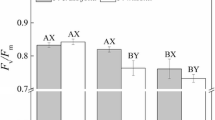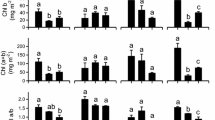Summary
A total of 22 grass species were examined from 5 sites spanning the altitudinal range 1550–4350 m.a.s.l. The presence of the C3 or C4 photosynthetic pathway was determined from δ13C values and chilling tolerance was assessed on the basis of electrolyte leakage from leaf slices incubated on melting ice. Most of the grasses studied at the lower altitude sites of 1550 m.a.s.l. (annual mean of daily minimum temperature, 14.6° C) and 2600 m.a.s.l. (9.4° C) possessed C4 photosynthesis and were chill-sensitive. The single except ion was Agrostis avenacea, a montane chill-resistant C3 species which occurred at 2600 m.a.s.l. The three species apparently most sensitive to chilling were Ischaemum polystachyum, Paspalum conjugatum and Saccharum robustum, all occurring at 1550 m.a.s.l. At the higher altitude sites of 3280 (5.6° C), 3580 (4.0° C) and 4350 (−0.7°C) m.a.s.l., most of the grasses exhibited C3 photosynthesis and were chill-resistant. However, an Upland population of the C4 species, Miscanthus floridulus was found at 3280 m.a.s.l. which had acquired chill-resistance as confirmed by additional in vivo variable chlorophyll fluorescence measurements. Cell sap osmotic potential values of the upland grasses at altitudes of 3280–4350 m.a.s.l. were lower (−8.1 to −19.8 bars) than values in grasses from 1550 and 2600 m.a.s.l. (−3.9 to −7.5 bars) due mainly to the presence of non-electrolyte osmoticants, which may be involved in frost avoidance mechanism(s).
Similar content being viewed by others
Abbreviations
- ABA:
-
abscisic acid
- FR :
-
the maximal rate of rise of induced chlorophyll fluorescence
- ψs:
-
osmotic potential
References
Beck E, Senser M, Scheibe R, Steiger H-M, Pongratz P (1982) Freezing avoidance and freezing tolerance in Afroalpine “giant rosette” plants. Plant Cell Environ 5:215–222
Berry JA, Raison JK (1981) Responses of macrophytes to temperature: In: Lange OL, Nobel PS, Osmond CB, Ziegler H (eds) Physiological plant ecology. Encycl Plant Physiol, New Series, Vol 12A. Springer, Berlin Heidelberg New York, pp 277–338
Bishop DG (1986) Chilling sensitivity in higher plants: the role of phosphotidylglycerol. Plant Cell Environ 9:613–616
Caldwell MM, Osmond CB, Nott DL (1977) C4 pathway photosynthesis at low temperature in cold-tolerant Atriplex species. Plant Physiol 60:157–164
Chen H-H, Li PH (1980) Characteristics of cold acclimation and deacclimation in tuber-bearing Solanum species. Plant Physiol 65:1146–1148
Chen H-H, Li PH, Brenner ML (1983) Involvement of abscisic acid in potato cold acclimation. Plant Physiol 71:362–365
Christiansen MN, St John JB (1981) The nature of chilling injury and its resistance in plants: In: Olien CR, Smith MN (eds) Analysis and improvement of plant cold hardiness. CRC Press, Boca Raton Fla.
Clarkson DT, Earnshaw MJ, White PJ, Cooper HD (1988) Temperature-dependent factors influencing nutrient uptake: an analysis of responses at different levels of organisation. In: Long SF, Woodward FE (eds) Plants and temperature. Symp Soc Exp Biol, Vol 42. The Company of Biologists Ltd, Cambridge, pp 281–309
Dear J (1973) A rapid degradation of starch at hardening temperatures. Cryobiol 10:78–81
Earnshaw MJ, Carver KA, Lee JA (1985) Changes in leaf water potential and CAM in Sempervivum montanum and Sedum album in response to water availability in the field. Oecologia 67:486–492
Earnshaw MJ, Winter K, Ziegler H, Stichler W, Cruttwell NEG, Kerenga K, Cribb PJ, Wood J, Croft JR, Carver KA, Gunn TC (1987) Altitudinal changes in the incidence of crassulacean acid metabolism in vascular epiphytes and related life forms in Papua New Guinea. Oecologia 73:566–572
Earnshaw MJ, Gunn TC, Croft JR (1988) Shoot temperature measurements of montane Cyathea (Cyatheaceae: Pteridphyta) species in Papua New Guinea. Fern Gaz 13:209–216
Ehleringer JR (1978) Implications of quantum yield differences on the distributions of C3 and C4 grasses. Oecologia 31:255–267
Green DG (1972) The relationship between plant sugar concentration, osmotic potential, and frost tolerance in Kharkov MC22 winter wheat. Sugar and frost tolerance. Can J Bot 50:677–680
Green DG, Ratzlaff CD (1975) An apparent relationship of soluble sugars with hardiness in winter wheat varieties. Can J Bot 53:2198–2201
Hacker JB, Forde BJ, Gow JM (1974) Simulated frosting of tropical grasses. Aust J Agric Res 25:45–57
Heber U, Schmitt JM, Krause GH, Klosson RJ, Santarius KA (1981) Freezing damage to thylakoid membranes in vitro and in vivo: In: Morris CJ, Clarke A (eds) Effects of low temperature on biological membranes. Academic Press, London, pp 263–283
Hedberg J, Hedberg O (1979) Tropical-alpine life-forms of vascular plants. Oikos 33:297–307
Henty EE (1969) A manual of the grasses of New Guinea. Botany Bull no 1, Dept Forests, Lae, Papua New Guinea
Hetherington SE, Smillie RM, Hardacre AK, Eagles HA (1983a) Using chlorophyll fluorescence in vivo to measure the chilling tolerances of different populations of maize. Aust J Plant Physiol 10:247–256
Hetherington SE, Smillie RM, Malagamba P, Huaman Z (1983b) Heat tolerance and cold tolerance of cultivated potatoes measured by the chlorophyll-fluorescence method. Planta 159:119–124
Hincha DK, Schmidt JE, Heber U, Schmitt JM (1984) Colligative and non-colligative freezing damage to thylakoid membranes. Biochim Biophys Acta 769:8–14
Hnatiuk RJ, Smith JMB, McVean DN (1976) The climate of Mt. Wilhelm. Mt. Wilhelm Studies 2. ANU BG/4, Canberra
Hope GS (1980) New Guinea mountain vegetation communities. In: van Royen P. The alpine flora of New Guinea, Vol. 1. J. Cramer, Vaduz, pp 113–122
Humphreys GS (1984) The environment and soils of Chimbu Provice, Papua New Guinea, with particular reference to soil erosion. Research Bull 35, DPI, Port Moresby
Johns RJ, Stevens PF (1971) Mount Wilhelm flora. A check list of species. Botany Bull no 6, Division Bot, Dept Forests, Lae, Papua New Guinea
Kenrick JR, Bishop DG (1986) The fatty acid composition of phosphotidylglycerol and sulfoquinovosyldiacylglycerol of higher plants in relation to chilling sensitivity. Plant Physiol 81:946–949
Körner Ch, Allison A, Hilscher H (1983) Altitudinal variation of leaf diffusive conductance and leaf anatomy in heliophytes of montane New Guinea and their interrelation with microclimate. Flora 174:91–135
Körner Ch, Larcher W (1988) Plant life in cold climates: In: Long SF, Woodward FI (eds) Plants and temperature. Symp Soc Exp Biol, Vol 42. The Company of Biologists Ltd, Cambridge, 25–57
Körner Ch, Farquhar GD, Roksandic Z (1988) A global survey of carbon isotope discrimination in plants from high altitude. Oecologia 74:623–632
Larcher W (1982) Typology of freezing phenomena among vascular plants and evolutionary trends in frost acclimation: In: Li PH, Sakai A (eds) Plant cold hardiness and freezing stress. Academic Press, New York, pp 417–426
Lee ASJ, Lüttge U, Smith JAC, Cram WJ, Diaz M, Griffiths H, Popp M, Schafer C, Stimmel K-H, Thonke B (1989) Ecophysiology of xerophytic and halophytic vegation of a coastal alluvial plain in Northern Venezuela. III. Bromelia humilis Jacq., a terrestrial CAM bromeliad. New Phytol 111:253–271
Li PH, Fennell A (1985) Potato frost hardiness: In: Li P (ed) Potato physiology. Academic Press, London, pp 457–479
Long SP (1983) C4 photosynthesis at low temperatures. Plant, Cell Environ 6:345–363
Lyons JM (1973) Chilling injury in plants. Ann Rev Plant Physiol 24:445–466
Lyons JM, Graham D, Raison JK eds (1979) Low temperature stress in crop plants: the role of the membrane. Academic Press, London, New York
MacRae EA, Hardacre AK, Ferguson IB (1986) Comparison of chlorophyll fluorescence with several other techniques used to assess chilling sensitivity in plants. Physiol Plant 67:659–665
McAlpine JR, Keig G, Short K (1975) Climatic tables for Papua New Guinea, CSIRO, Melbourne
Michaelis P (1934) Ökologische Studien an der alpinen Baumgrenze V. Osmotischer Wert und Wassergehalt während des Winters in den verschiedenen Höhenlagen, Jahrbuch Wiss Botanik 80:337–362
Minorsky PV (1985) A heuristic hypothesis of chilling injury in plants: a role for calcium as the primary physiological transducer of injury. Plant, Cell Environ 8:75–94
Mooney HA, Billings HD (1965) Effects of altitude on carbohydrate content of mountain plants. Ecology 46:750–751
Murata N (1983) Molecular species composition of phosphatidylglycerols from chilling-sensitive and chilling-resistant plants. Plant Cell Physiol 24:81–86
O'Leary MH (1981) Carbon isotope fractionation in plants. Phytochemistry 20:553–568
Osmond CB, Winter K, Ziegler H (1982) Functional significance of different pathways of CO2 fixation in photosynthesis: In: Lange OL, Nobel PS, Osmond CB, Ziegler H (eds) Physiological plant ecology II. Encycl Plant Physiol, New Series, Vol 12B. Springer, Berlin Heidelberg New York, pp 481–547
Pantis JD, Diamantoglou S, Margaris NS (1978) Altitudinal variations in total lipid and soluble sugar content in herbaceous plants on Mount Olympus (Greece), Vegetatio 72:21–25
Patterson BD, Murata T, Graham D (1976) Electrolyte leakage induced by chilling in Passiflora species tolerant to different climates. Aust J Plant Physiol 3:435–442
Paull RE (1981) Temperature-induced leakage from chilling-sensitive and chilling-resistant plants. Plant Physiol 68:149–153
Rada F, Goldstein G, Azocar A, Meinzer F (1985) Daily and seasonal osmotic changes in a tropical treeline species. J Exp Bot 36:989–1000
Raison JK, Wright LC (1983) Thermal phase transitions in the polar lipids of plant membranes: their induction by disaturated phospholipids and their possible relation to chilling injury. Biochim Biophys Acta 731:69–78
Rees Tap, Dixon WL, Pollock CJ, Franks F (1981) Low temperature sweetening of higher plants. In: Friend J, Rhodes MJC (eds) Recent advances in the biochemistry of fruits and vegetables. Academic Press, New York, pp 41–61
Rikin A, Blumenfeld B, Richmond AE (1976) Chilling resistance as affected by stressing environments and abscisic acid. Bot Gaz 137:307–312
Rundel PW (1980) The ecological distribution of C4 and C3 grasses in the Hawaiian islands. Oecologia 45:354–359
Sakai A, Larcher W (1987) Forst survival of plants. Responses and adaptation to freezing stress. Ecological Studies, Vol 62. Springer, Berlin Heidelberg New York
Siddiqi MY, Memon AR, Glass ADM (1984) Regulation of K+ influx in barley. Effects of low temperatures. Plant Physiol 74:730–734
Smillie RM, Hetherington SE (1983) Stress tolerance and stress-induced injury in crop plants measured by chlorophyll fluorescence in vivo. Plant Physiol 72:1043–1050
Smillie RM, Hetherington SE, Ochoa C, Malagamba P (1983) Tolerances of wild potato species from different altitudes to cold and heat. Planta 159:112–118
Smillie RM, Nott R, Hetherington SE, Oquist G (1987) Chilling injury and recovery in detached and attached leaves measured by chlorophyll fluorescence. Physiol Plant 69:419–428
Smith JMB (1977a) Origins and ecology of the tropicalpine flora of Mt Wilhelm, New Guinea. Biol J Linnean Soc 9:87–131
Smith JMB (1977b) Vegetation and microclimate of east- and west-facing slopes in the grasslands of Mt Wilhelm, Papua New Guinea. J Ecol 65:39–53
Smith JMB (1977c) An ecological comparison of two tropical high mountains. J Trop Geogr 44:71–80
Taylor AO, Halligan G, Rowley JA (1975) Faris banding in panicoid grasses. Aust J Plant Physiol 2:247–251
Tieszen LL, Senyimba MM, Imbamba SK, Troughton J (1979) The distribution of C3 and C4 grasses and carbon isotope discrimination along an altitudinal and moisture gradient in Kenya. Oecologia 37:337–350
van Royen P (1980) The alpine flora of New Guinea. J Cramer, Vaduz
Wade LK, McVean DN (1969) Mt Wilhelm Studies I. The alpine and subalpine vegetation. AnU BG/1, Canberra
Walker D (1968) A reconnaissance of the non-arboreal vegetation of the Pindaunde catchment, Mount Wilhelm, New Guinea. J Ecol 56:445–466
Young HJ, Young TP (1983) Local distribution of C3 and C4 grasses in sites of overlap on Mount Kenya. Oecologia 58:373–377
Author information
Authors and Affiliations
Rights and permissions
About this article
Cite this article
Earnshaw, M.J., Carver, K.A., Gunn, T.C. et al. Photosynthetic pathway, chilling tolerance and cell sap osmotic potential values of grasses along an altitudinal gradient in Papua New Guinea. Oecologia 84, 280–288 (1990). https://doi.org/10.1007/BF00318285
Received:
Accepted:
Issue Date:
DOI: https://doi.org/10.1007/BF00318285




